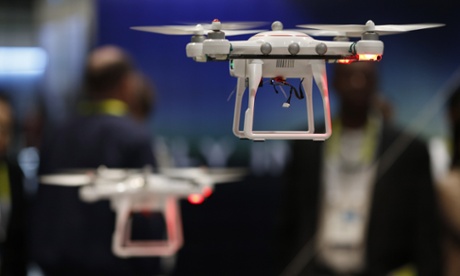
The prospect of drones delivering parcels to your doorstep is still some way off. But the use of unmanned aerial vehicles (UAVs) for humanitarian work in developing countries is already happening.
When medical nonprofit Médecins Sans Frontières, or Doctors Without Borders, set up a tuberculosis diagnosis station in Papua New Guinea in May, one of its first calls was to Silicon Valley-based UAV firm Matternet.
“They called, and said it was impossible to do this [mission] in a traditional way, because the roads are very bad, where they exist, and in the rainy season it is completely blocked,” recounts Matternet CEO Andreas Raptopoulos. “They estimated that as many as 10,000 patients needed to be diagnosed, the majority living rurally.”
Matternet, which had previously run trial projects with Doctors Without Borders in Haiti and the World Health Organisation in Bhutan, deployed UAVs with a range of up to 28km (17 miles) to carry diagnostic samples of circa 1kg (2lbs) from rural villages to a central lab. Flying autonomously, each follows GPS co-ordinates typed in using a mobile phone app. “Even if you only use one or two UAVs a day, you can pick up 10 samples from 10 different points,” explains Raptopoulos. “When you go by land, it is really hard just to get from A to B.”
Matternet isn’t the only private enterprise making drones for development.
Canada-based Aeryon Labs was founded in 2007 to work predominantly on military craft. However, when Typhoon Hagupit hit the Philippines in December, Aeryon offered a drone to the disaster response nonprofit Global Medic. The drone took a series of images that were stitched together to create a map of the affected area and quickly help response teams focus their relief efforts, says Dave Kroetsch, CEO of Aeryon Labs.
“Global Medic is often placed in response situations where surroundings have drastically changed: roads are flooded, houses are gone, people have migrated to different areas for food or shelter,” Kroetsch explains. “Providing Global Medic with [a UAV] enables the response team to have eyes in the sky in about two minutes.”
Rahul Singh, a Global Medic paramedic and a veteran of over 30 international relief missions, believes that UAVs could be useful for many different tasks, including search and rescue, emergency mapping, figuring out population movements and mapping out damaged homes, all at a higher resolution and a cheaper cost than using helicopters and satellites.
“This technology could be a game changer in making us more efficient as humanitarian responders,” he said.
Meanwhile, Switzerland-based Drone Adventures has deployed mapping drones in Haiti and in the Philippines. Danish firm Sky-Watch, in cooperation with DanChurch Aid, has used airborne thermal imagery to spot people stranded amongst storm debris.
There are signs more drones are coming to developing countries. A team from Delft University of Technology, in the Netherlands, has created a UAV with built-in defibrillation equipment. And the Aerial Robotics Laboratory at Imperial College London is working to set up African drone networks to deliver blood supplies to rural health clinics.
The idea of involving drones in development is not without its critics, however. When the UN peacekeeping force Monusco used drones in the Democratic Republic of the Congo last May, World Vision’s Frances Charles warned that “communities are likely to associate the UAVs with the military”.
“We are here to help, and none of us – aid agencies, governments or UN agencies – can afford for that message to be muddied,” he said.
A recent UN policy paper, Unmanned Aerial Vehicles in Humanitarian Response, also raised concerns over legal issues, privacy violation, ethical procurement (given many drone companies also supply the military) and informed consent.
For development workers on the ground, drones’ cost and reliability are even more pressing challenges. Getting reliability at low cost “is the hardest challenge”, Raptopoulos said. “People assume because you can see all these great videos on you-tube, that the technology is already super reliable and super robust. It is not.”
Starting in 2015, Matternet will guarantee a loss of no more than one mission out of a thousand, he said. With the prospect of carrying potentially contagious medical samples, however, that may not be good enough.
Cost efficiency is hard to measure at the moment, Singh added. Global Medic’s Aeryon UAV was donated and the $68,000 price tag would be hard for the charity to afford. Given the competition in this fast-developing market, however, costs are rapidly coming down. Matternet plans to sell its first off-the-shelf UAV specifically for development work for $5,000 starting this spring.
“Over a year that’s something like $12-$15 a day,” Raptopoulos said. “If you are able to do 10 deliveries and pickups a day, that’s a very appealing value proposition if [currently] you have to commission expensive land cruisers.”
When it comes to using UAVs for disaster response, Ronald Christiaans, training coordinator at the National Operations Centre in the Netherlands, is a convert after the 2013 Haiyan typhoon in the Philippines.
“If [UAVs] had been deployed in the first 72 hours after the disaster, it would have certainly helped to save lives,” he says, adding that it is now a priority to equip first-response teams, humanitarian and relief organizations with the tool.
So far, though, only a few early adopters are embracing UAVs for development, while others wait for the problems to be ironed out. But Raptopoulos and others in the drone industry believe widespread adoption is only one or two years away.
“[NGOs are] not accustomed to taking technology risk,” Raptopoulos said. “But in the case of extreme need, this changes.”
The role of business in development hub is funded by Business Call to Action. All content is editorially independent except for pieces labelled ‘brought to you by’. Find out more here.

